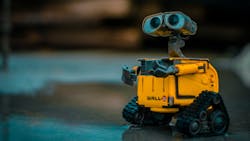Even in an environment where remote work is normalizing and investments in robotics are paying rewards, robots are still not taking over the production environment. In many of the best use cases robots remain complementary – to humans as well as other technologies.
The human element is critical to making AI and robots work, explains Daniel Theobald, CEO of Vecna Robotics. “As counterintuitive as it sounds, human workers are essential to all manufacturing processes that include autonomous systems. In a facility that employs AI, robots and workers, each plays a unique role,” he says.
AI is constantly scanning, looking for and learning from opportunities to create greater operational efficiencies, and communicating with workers through wearables and robots to deploy them to solve problems in real-time. Robots are used for automating routine, repetitive, dangerous jobs, such as lineside replenishment, racking, and staging. Supported by AI and automation, humans can then turn their attention to higher-value activities, like exception handling and creative problem-solving.
“We have seen this allocation of tasks between our pivotal orchestration engine, autonomous mobile robots and workers in a production environment result in high employee satisfaction and engagement,” says Theobald.Ongoing evolution
Early adopters of automation have validated the functionality of autonomous mobile robots (AMRs). According to Theobald, the next clear step is pushing interoperability forward. “This is interoperability between AMRs and warehouse management systems, enterprise resource planning systems and manufacturing execution systems; AMRs and humans; and, most importantly, between AMRS of different makes and models,” he says. “There is no one-size-fits-all robot. The typical industrial facility will require many types of robots to handle many types of applications. To effectively orchestrate tasks, interoperability amongst platforms is imperative.”
However, Theobald explains, sometimes the hardest part is getting started. “Manufacturers can get over the hump by starting small and then scaling their use of AI and automation,” he says.
The first route is to begin collecting information using real-time location services (RTLS) to gather data across all robots, workers, assets, pallets and manual equipment. “Our customers can collect data, including resource usage, distance traveled, travel time vs. idle time, deadheading, and high-traffic routes through a facility,” he says. “This data is a low-cost way to identify areas for improvement and can be used as a way to simulate and assess multiple scenarios to determine optimal resource utilization and automation mix. Understanding what’s really going on in your operation is the key to unlocking significant value.”
About the Author
Peter Fretty
Managing Editor
As a highly experienced journalist, Peter Fretty regularly covers advances in manufacturing, information technology, and software. He has written thousands of feature articles, cover stories, and white papers for an assortment of trade journals, business publications, and consumer magazines.
